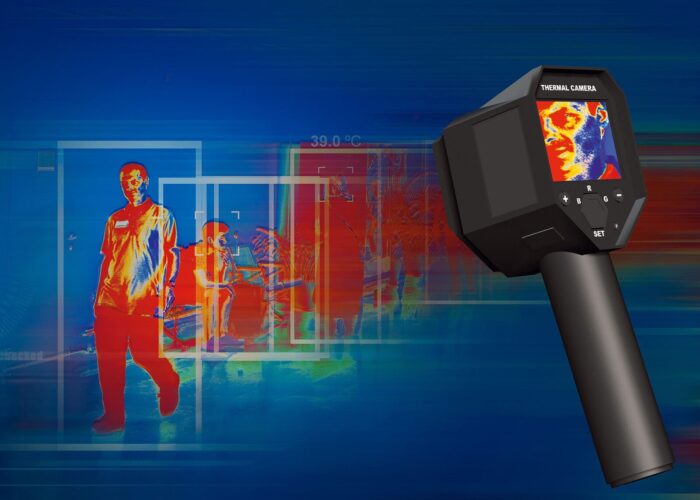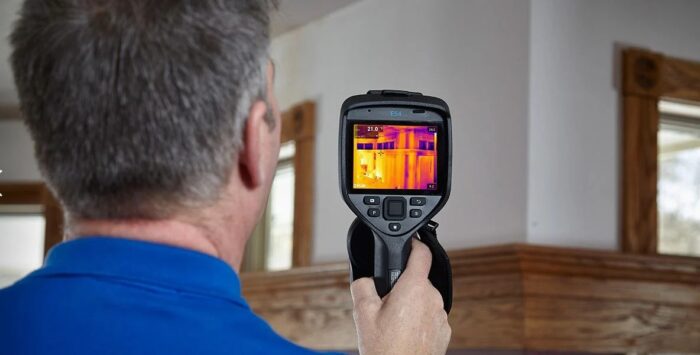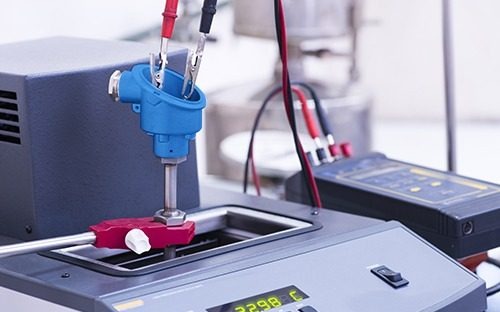Thermal sensors are gadgets that detect and measure temperature modifications by changing thermal vitality into electromagnetic indicators. They function on the precept of thermal radiation, which is the vitality emitted by objects based mostly on their temperature.
The important thing part in thermal sensors is often a fabric that modifications its electrical properties in response to temperature variations.
For instance, thermocouples, probably the most extensively used forms of thermal sensors, operate by means of the Seebeck impact, the place two completely different metals generate a voltage when uncovered to completely different temperatures. Different sorts embrace thermistors and infrared sensors.
Their performance makes them important in a plethora of purposes—from easy family thermostats to superior industrial temperature administration techniques.
The Evolution of Thermal Sensing Expertise


The origin of thermal sensing expertise might be traced again to the early nineteenth century with the invention of the primary thermocouple by Thomas Johann Seebeck.
Initially, the give attention to thermal sensors was restricted to fundamental temperature measurement. Nonetheless, speedy advances in supplies science and electronics have led to vital developments within the capabilities of thermal sensors.
Over the a long time, applied sciences corresponding to micro-electromechanical techniques (MEMS) and nanotechnology have emerged, permitting for extremely delicate and miniaturized sensors that present quicker response instances and improved accuracy.
In the present day, the evolution continues with the combination of sensible applied sciences. The introduction of digital thermal sensors, which supply on-device sign processing and higher connectivity choices, has reworked conventional purposes.
Moreover, developments in non-contact infrared sensors enable for real-time thermal imaging throughout numerous purposes, together with surveillance and medical diagnostics.
Key Terminology and Ideas You Ought to Know
To completely perceive thermal sensors and their purposes, it’s crucial to turn into conversant in some key terminologies.
As an illustration, the time period “thermal conductivity” refers to a fabric’s means to conduct warmth, which performs an important position within the accuracy of thermal measurements.
One other vital idea is “sensitivity,” which is the smallest change in temperature {that a} sensor can precisely detect.
Moreover, understanding the distinction between contact and non-contact sensors is important, because it influences their applicability in numerous fields.
Contact sensors measure temperature by means of bodily contact with the item, corresponding to thermocouples, whereas non-contact sensors infer temperature from the thermal radiation emitted by an object, corresponding to infrared sensors.
Revolutionizing Industries: Thermal Sensors in Motion
Good Houses: Enhancing Consolation and Effectivity


As expertise permeates our every day lives, the position of thermal sensors in sensible properties has turn into more and more vital. They contribute to vitality administration and occupant consolation by means of exact local weather management techniques.
As an illustration, sensible thermostats geared up with thermal sensors can be taught person habits—adjusting the heating and cooling techniques accordingly to optimize vitality consumption whereas guaranteeing consolation.
This not solely reduces utility payments but in addition minimizes the environmental influence by chopping down on pointless vitality waste.
Furthermore, thermal sensors are additionally built-in into safety techniques. They’ll detect uncommon warmth patterns in an setting, which can point out the presence of intruders or sudden occurrences corresponding to fires.
This integration into the house automation ecosystem gives peace of thoughts for householders and may considerably improve general security.
Healthcare Improvements: Monitoring Affected person Wellness
Within the healthcare business, thermal sensors have paved the best way for developments in affected person monitoring and diagnostics.
One of the vital frequent purposes is in fever detection by means of contactless infrared thermometers.
These gadgets have gained immense reputation, particularly throughout well being crises like pandemics, permitting for fast and correct temperature readings with out bodily contact, thereby decreasing the chance of cross-contamination.
Past fever detection, wearable thermal sensors have gotten more and more prevalent in steady well being monitoring.
These gadgets can monitor physique temperature fluctuations in real-time, aiding with the administration of power sicknesses or restoration post-surgery.
The flexibility to supply instantaneous suggestions permits healthcare professionals to reply quicker to potential well being points, bettering affected person outcomes considerably.
Industrial Purposes: Enhancing Security and Productiveness
Thermal sensors play a pivotal position in industrial settings, enabling improved security and enhanced productiveness.
In manufacturing processes, thermal sensors are utilized for temperature monitoring essential in numerous purposes corresponding to high quality management, tools upkeep, and course of optimization.
For instance, in industries corresponding to prescription drugs and meals processing, sustaining particular temperature ranges is essential to make sure product security and high quality.
Right here, thermal sensors present real-time information that helps in adhering to stringent regulatory requirements.
Moreover, thermal sensors can improve office security by monitoring tools temperatures to forestall overheating and potential failures.
With predictive upkeep enabled by steady thermal monitoring, firms can scale back downtime and keep away from pricey repairs.
General, the combination of thermal sensor applied sciences in industrial operations results in a extra environment friendly, protected, and productive work setting.
Future Developments: The Subsequent Frontier of Thermal Sensor Expertise


AI and Machine Studying: A Excellent Match for Thermal Sensors
The convergence of AI and machine studying with thermal sensor expertise is poised to revolutionize numerous sectors.
By combining the data-rich output from thermal sensors with subtle AI algorithms, techniques can be taught to foretell temperature-related anomalies or potential failures a lot sooner than conventional strategies.
Machine studying can refine and improve sensor information interpretation, leading to extra correct and dependable monitoring techniques.
This synergy can notably profit industries the place normal operational temperature ranges are essential.
AI-driven thermal imaging techniques can analyze thermal patterns in real-time, offering insights that may result in preventative actions slightly than reactive repairs.
This paradigm shift is not going to solely improve operational effectivity but in addition considerably decrease prices related to downtime and tools failure.
Integration with IoT: Making a Linked Universe
The Web of Issues (IoT) is basically altering how thermal sensors are utilized throughout numerous sectors.
By embedding thermal sensors into IoT networks, information might be collected, analyzed, and disseminated in actual time, resulting in unprecedented management and administration capabilities.
This integration permits for smarter vitality grids, improved useful resource allocation, and real-time local weather administration in sensible cities.
In sensible buildings, IoT-enabled thermal sensors can dynamically modify heating and cooling based mostly on occupancy patterns, enhancing person consolation whereas selling vitality effectivity.
Furthermore, in agricultural purposes, thermal sensors can present essential information about crop temperature situations, informing irrigation and planting methods, in the end driving agricultural productiveness.
The potential for IoT-enabled thermal sensors is huge, and as connectivity expands, we’re more likely to see much more modern purposes emerge.
Promising Analysis and Breakthroughs on the Horizon
The sector of thermal sensing is repeatedly evolving, with vital analysis targeted on enhancing sensor capabilities and increasing their purposes.
Rising applied sciences are exploring the event of self-healing thermal sensors and sensors with built-in nanotechnology that may present real-time suggestions with minimal vitality consumption.
These developments promise to make thermal sensors much more environment friendly and autonomous.
Moreover, analysis into new supplies, corresponding to graphene and superior polymers, is paving the best way for extra delicate and versatile thermal sensors.
This not solely broadens their applicability throughout various environments but in addition will increase their sturdiness and operational lifespan. With ongoing breakthroughs, the way forward for thermal sensors will seemingly maintain much more transformative potential throughout a number of industries.
Challenges and Concerns: Navigating the Thermal Sensor Panorama


Frequent Pitfalls in Thermal Sensor Implementation
As organizations look to combine thermal sensors into their operations or merchandise, it’s essential to pay attention to frequent pitfalls that may impede their effectiveness.
One vital problem is the calibration of thermal sensors. Incorrectly calibrated gadgets can result in inaccurate information readings, which might be detrimental in high-stakes environments corresponding to healthcare or manufacturing.
Correct coaching and protocols for set up and ongoing upkeep are essential for guaranteeing sensor accuracy and reliability.
Furthermore, organizations should think about the selection of sensors based mostly on their particular environmental situations.
As an illustration, sensors utilized in excessive temperatures or harsh situations might require particular supplies to operate successfully.
Understanding these nuances upfront can stop pricey errors and enhance long-term outcomes.
Environmental Impacts and Sustainability Elements
Sustainability is turning into an more and more essential consideration within the improvement and utility of thermal sensors.
The manufacturing and disposal of sensor applied sciences pose environmental challenges, notably when contemplating the supplies utilized in sensor manufacturing and the digital waste generated.
As firms attempt for greener practices, there’s a push to develop extra sustainable supplies and processes for sensor manufacturing.
Furthermore, the deployment of thermal sensors in vitality administration techniques performs a big position in decreasing vitality consumption, thereby positively impacting the setting in the long term.
The problem lies in balancing innovation with environmental duty, guaranteeing that expertise developments don’t come at too excessive an ecological price.
Future-proofing Your Thermal Sensor Options
In a quickly evolving technological panorama, organizations should assume forward to make sure their thermal sensor options stay related and efficient.
One technique for future-proofing entails deciding on modular and upgradable sensor techniques that may incorporate developments in expertise with out requiring full overhauls.
Organizations also needs to put money into coaching groups to be adaptive and aware of the altering expertise and market calls for.
Moreover, leveraging cloud-based information analytics can improve the longevity of thermal sensor techniques.
By harnessing the ability of huge information, organizations can higher interpret sensor information and adapt their methods based mostly on real-time insights.
General, a proactive strategy to expertise integration and scalability might be very important in sustaining aggressive benefit in an more and more data-driven world.

